When it comes to legit bluesy grooves, tongue-blocking 👅
is the only path to the sound. Here’s how to do it….
This shuffle groove is great for adding rhythmic harmonica playing behind a singer or soloist.
And I especially love playing this style when I’m alone. It mimics the sound of a whole band: the single notes emulate a bassline, punctuated by the chords a piano or guitar might add.
As always, I’ve got a C harmonica, and this groove is in 2nd position, in the key of G.
Level1Isolating Notes
Using Tongue-Blocking
We are going to begin our journey by learning how to isolate -2 with tongue-blocking.
To begin, play -12. Then we are going to use our tongue to cover up just hole -1.
- TONGUE is going DOWN and TO THE LEFT
- Playing hole -2 out of the right side of mouth
- Right lip is blocking hole 3.
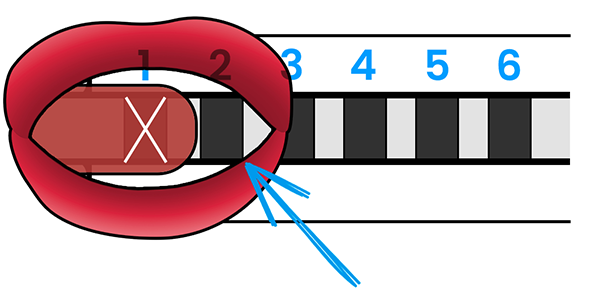
If you’ve been lip blocking for years you’re used to playing out of the center of your lips, so if you’re like me, it may seem VERY STRANGE to be playing out of the right corner of the mouth, BUT this IS the CORRECT way to play using tongue-blocking!
I recommend not using the tip of the tongue to block the holes. I think it’s better to have the tip of the tongue going down and using this part of the tongue to block the holes.

For this basic groove we only need to isolate 3 notes: the -2 and 2 (which we’ve just learned about) and the -1.
For the -1 we are going to SWITCH our TONGUE TO THE RIGHT side of the HOLE, and play out of the left side of the mouth.
Wait a sec. What? But you just said..
I know I just told you that for tongue-blocking we play out of the right side of the mouth, and that’s almost always true, but for the -1 we will SWITCH the tongue to the right side.
👅Two Mouths👅
One huge advantage of tongue-blocking is we can play out of either side of the mouth. The net result is basically we now have 2 mouths!
This is how we can play splits, such as playing holes 1 & 4 at the same time.
We also can jump back and forth between holes 1 & 4 quickly, called tongue-switching, which we’ll explore more in level 7.
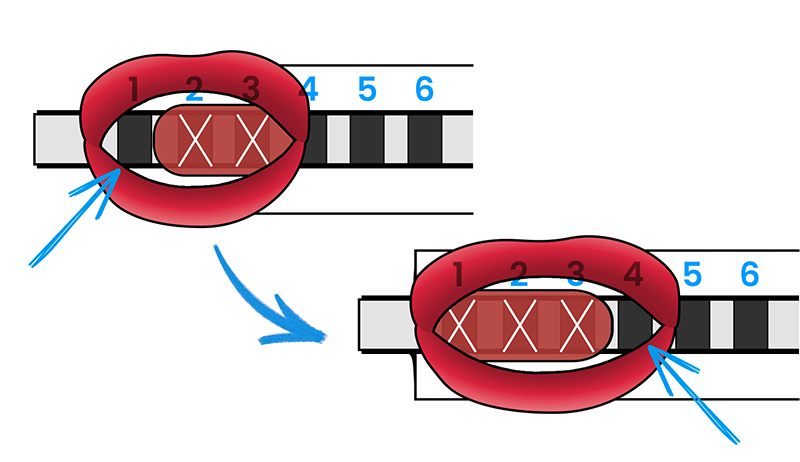
But for right now we’re playing -1 out of the left corner of our mouth and blocking holes 2 & 3 with our tongue down and to the right.
Here’s the tabs for our first exercise:
-2 2 -1 2 (repeat)
Again, the tongue is on the left side when we’re playing hole 2, and on the right side when we’re playing hole 1.
If you’re feeling frustrated right now, don’t worry! It’s normal for this to feel very awkward at the beginning and to take a period of weeks or months for this to start to feel comfy.
⚠️ PLEASE NOTE: this is NOT the EASIEST way to isolate notes ⚠️
I teach the easiest way to isolate notes in my lesson Single Notes for Beginners.
If you’re a beginner and this lesson is making you wanna quit, DON’T DO IT.
Instead, make this your #1 goal: to stay inspired.
If this isn’t inspiring you, go check out my beginner lesson right now, which is how 99.9% of people find the easiest way to isolate notes. You can always come back to this later.
But if you’re still feeling stoked about playing this killer groove, then let’s go to level 2…
Level2Tongue-Lifting
We are going to play the same thing we just did: -2 2 -1 2, but after each single note…
Now we are going to “lift our tongue” back from the comb,
allowing the -12 or 12 chord to come through.
And this is where the magic✨ begins to happen.
Let’s groove.
-2 -12 2 12 -1 -123 2 12
So anywhere you see the -12 or 12 tabs, we are NOT using our lungs to make that sound.
Here is a what the inside of the mouth looks like when playing this pattern:
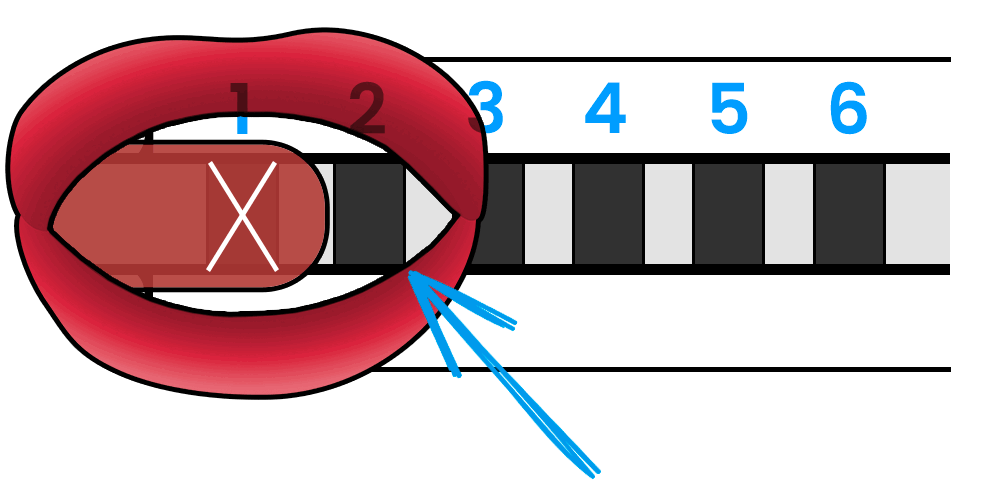
If that’s a bit too fast to follow, below are all the steps in the pattern, follow them at your own pace.
We are on the same continuous breath from the preceding single note, and we are simply lifting our tongue off of the comb, by pulling it back and allowing the chord to come through.
In the tabs, the holes that are blue are sound from the tongue lifting.
This is very important, this is what we’re learning to do right now:
Isolate a note using tongue-blocking.
Then lift the tongue to allow the chord to sound.
If you’ve hung on this long, congratulations. I’m proud of you! 👊🏼
You may need to work on tongue-lifting for several days or several weeks, and then come back to this lesson for level 3…
Level3Making It Swing
Because, as Ella Fitzgerald said:
It don’t mean a thing if ain’t got that swing!
💃🎶
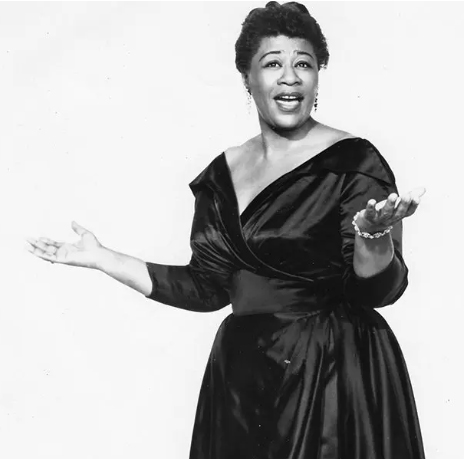
In our Level 2 tongue-lifting pattern, we were playing what we call straight 8th notes.
The chords came exactly halfway in between each single note.
What we wanna do now is push each one of those chords later, closer to the next single note downbeat.
This is called swing, also described by the terms swung 8ths, shuffle, boogie, and rag.
In order to figure out how far forward in time to push it, the 8th note triplet is our guide.
Say and clap this:
1-trip-let 2-trip-let 3-trip-let 4 trip-let
Don’t cheat now! You HAVE to ACTUALLY say the words with your mouth while clapping in order for this exercise to work. (Do it again.)
Next, DON’T clap when saying “trip”.
You are now playing a shuffle rhythm: the 2nd note is pushed closer to the next down beat.
Returning to our Level 2 tongue lifting tabs:
-2 -12 2 12 -1 -123 2 12
With a metronome on, hold the single notes for 2 clicks, lifting the tongue on the 3rd click.
Remember – we’re not breathing on the 3rd click. Each breath lasts 3 clicks, and we’re simply lifting our tongue back from the comb on the 3rd click.
One last tweak to turn this groove into the actual groove I’m playing at the top of the video…
Level4Making All the Chords Draws
Everything we’ve been working on so far is over the I chord.
If you don’t know what I mean when I say the I chord, IV chord, V chord, go check out my lessons Chords for Beginners and Blues for Beginners.
In order to make this riff sound really good over the I chord, we need to change all of our chords to DRAWS.
The way we have been doing it, when we’re playing the 2, we’re playing the 12 chords. We are now going to change those to -12 so everything is a draw. So now the bluesy shuffle groove tongue-blocking harmonica tabs are:
-2 -12 2 –12 -1 -123 2 –12
And right now my friend, if you were just playing that, then you were playing the exact groove I play at the top of the video. CONGRATULATIONS! Keep it up. Bringing it up to speed will just come with time.
Hey – if you’re enjoying these lessons, you might like to check out my Beginner to Boss course.
Now if today is your first day tongue-blocking and you’ve made it this far. WOW. That’s fricken unbelievable. I would probably say: that’s enough for today. Just go and work on that for a few weeks or a few months! 💪🏼
Over time you can increase the speed, and as you do I want to mention one thing, which is that up until now we’ve been playing the chords with our lungs.
Yes, we’ve been doing it all on one continuous breath, BUT with the breath of our lungs activating the chords. We want the chords to sound quieter than the single notes.
To get the dynamics right, we really want to sound the chords just with THE FORCE OF THE TONGUE coming back from the comb of the harmonica.
In the next sound example I’m gonna make the tempo a bit faster. It’s still quite slow, but fast enough to work on having those chords JUST sound FROM THE TONGUE, and not from our lungs. Check it out:
Now if you were able to keep up with that, you’re doing really great. And if that’s too fast, that’s perfectly normal.
Even though this lesson is totally suitable for beginners, all this coordination with the tongue takes time and can feel very frustrating. So again, not to sound like a broken record, but you may need to work for some weeks or months before this tongue-blocking bluesy shuffle harmonica groove starts to come together.
Level5The Tongue Slap
The final level of detail to turn this groove into a truly authentic Chicago Blues groove, that will make you legit in the eyes of all the tongue-blocking snobs on the internet. 😜
We are going to learn the tongue slap. Now the word slap can be MISLEADING, because to slap someone you have to use a lot of force.
But for the
TONGUE SLAP:
It’s ALL about TIMING,
you DON’T have to do it HARD.
Tongue Slapping can feel kind of ephemeral or mysterious, but ALL it is is simply:
Starting with a chord, and then blocking the chord to hear just the isolated note.
That’s it.
And I’ve never heard anyone talk about this before, but to my ear, the key 🔑 here is to play the chord QUIETLY and then block the chord with the tongue while increasing the volume of the single note.
As with everything in music, it’s best to start by practicing this VERY SLOWLY.
So we’re gonna forget about the chords for now and just focus on slapping -2, 2, -1, 2.
And, of course, on the -1 we are playing out of the left corner of our mouth and “slapping” our tongue on the right side of -1.
Ok, once you’re feeling comfortable (and this again is likely to take weeks or months), then you can try and add slaps to the single notes on our Level V groove:
Level6Adding the IV Chord
So far we’ve been only doing a I chord jam. And ain’t nothing wrong with that! (James Brown certainly made a comfortable living at it! 🕺🏿)
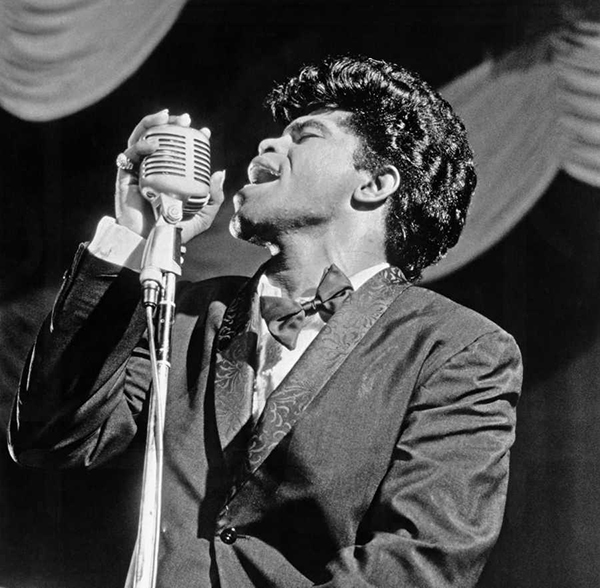
But since we harmonica players like to be bluesy, let’s take a step toward turning this groove into something we can play on a 12-Bar blues. And our first step on that journey is learning how to do something for the IV chord.
This is gonna be all blows, so take a deep breath before you start, grab a quick breath anywhere you can, and make sure no air is sneaking out of your nose while you play it (you can pinch your nose while you play it to confirm whether or not your nose is behaving itself 😉👃🏼).
Here’s the harmonica tabs for the IV Chord tongue-blocking bluesy shuffle groove:
1 12 2 12 3 123 3 123
Since we’re getting a bit more advanced now, I’m gonna increase our tempo, and we’re just gonna practice going back and forth between the I chord and IV chord, 2 bars per chord, like we’re looping the 2nd 4-bar phrase of a 12-Bar blues.
Level7The Final Frontier: The V Chord
As promised, we are now going to revisit the concept of tongue-switching introduced in Level 1.
To review, tongue-switching means quickly changing from drawing out of the left side of the mouth to drawing out of the right side of the mouth, and vice-versa.
Experiment with doing this between -1 to -4.
As with everything in the world of tongue-blocking on the harmonica, this is going to feel very awkward at the beginning. But it’s worth investing the time into the technique, because it will pay you great dividends.
As I mention in my Chords for Beginners lesson, when we’re playing in 2nd position as we are on this groove, we don’t have a proper V chord on the harmonica.
BUT we’re playing the chords quietly – we call it “ghosting” the chords.
So we’ll still play “ghost chords” to keep that funky rhythm going, and we can get away with it because they’re nice and quiet. I’m not gonna write the draw chords in the tab, but just put the letter D to signify sounding a draw chord between each note of the riff. Here are the harmonica tabs:
-1 D -4 D 4 D -4 D
As I mention in my Blues for Beginners lesson, the 12-Bar blues is made up of 3 phrases, and the 3rd phrase (which we’re working on now) is the V chord, IV chord, I chord, and the Turnaround.
In this 3rd phrase, for the IV chord, I think it’s nice to do a similar motif to what we did on the V chord. The ghost chords in this case will be blows, which I’m going to denote with the letter B.
Here are the harmonica tabs:
1 B 4 B -3 B 4 B
Technically that -3 should be bent down a half-step, -3’.
Now it IS possible to bend while tongue-blocking – the technique is raising the back of the tongue up into the “Kk” zone while keeping the part of the tongue closer to the tip on the harmonica, and once again it takes a lot of time to work that out.
For this lesson, we are NOT going to worry about that. The note passes fast, so we can just get away with an unbent -3. 😉
So let’s try doing V – IV – I, and then for our turnaround we’re just gonna draw twice on -1. Here’s the tabs:
V: -1 D –4 D 4 D -4 D
IV: 1 B 4 B -3 B 4 B
I: -2 -12 2 –12 -1 -12 2 -12
Turnaround: -2 -1 -1
Level8Putting it All Together
If you’ve made it here, please drop me a comment below so I can rejoice with you! 😎
It’s time to put it all together. Here are the harmonica tabs for the entire 12-Bar blues shuffle tongue-blocking groove. Rock on my harmonica brothers and sisters. 🤘🏼
Phrase 1:
-2 -12 2 –12 -1 -123 2 -12 (Repeat 4X)
Phrase 2:
1 12 2 12 3 123 3 123 (Repeat 2X)
-2 -12 2 –12 -1 -123 2 -12 (Repeat 2X)
Phrase 3:
-1 D -4 D 4 D -4 D
1 B 4 B -3 B 4 B
-2 -12 2 –12 -1 -12 2 -12
-2 -1 -1
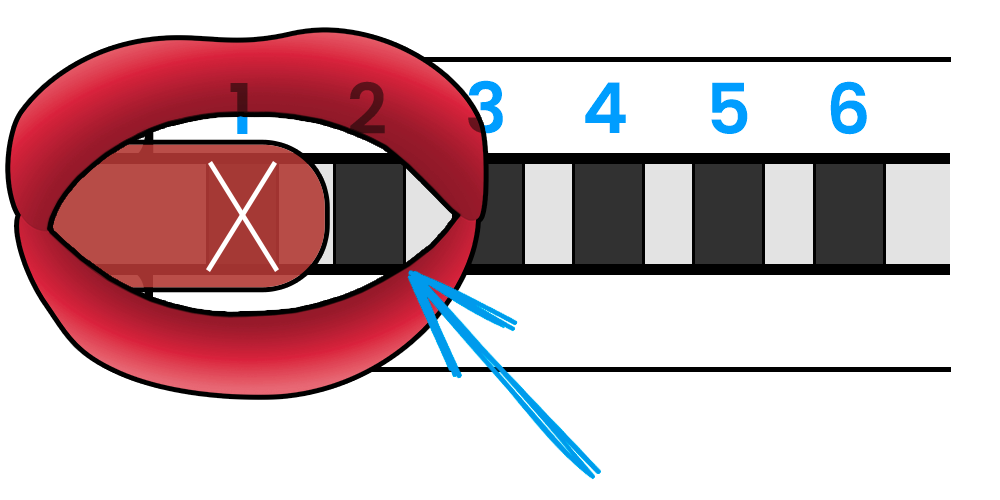
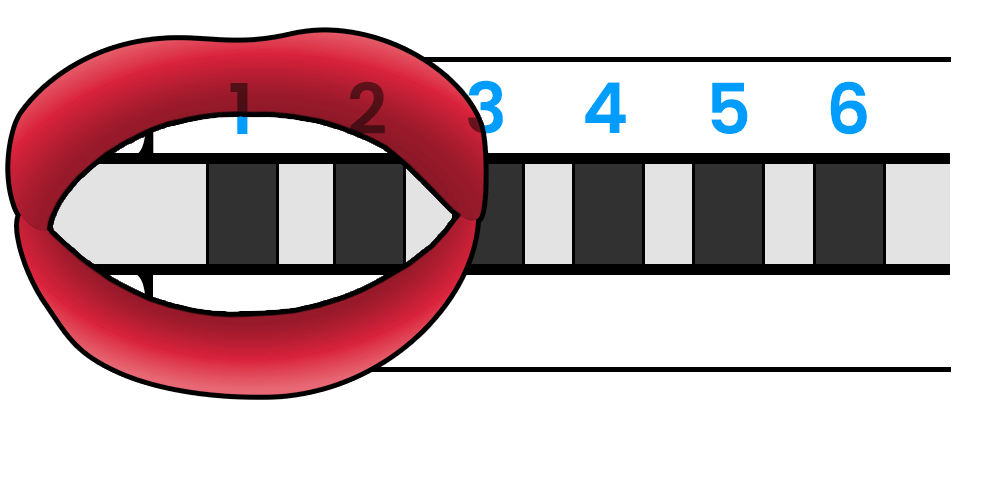
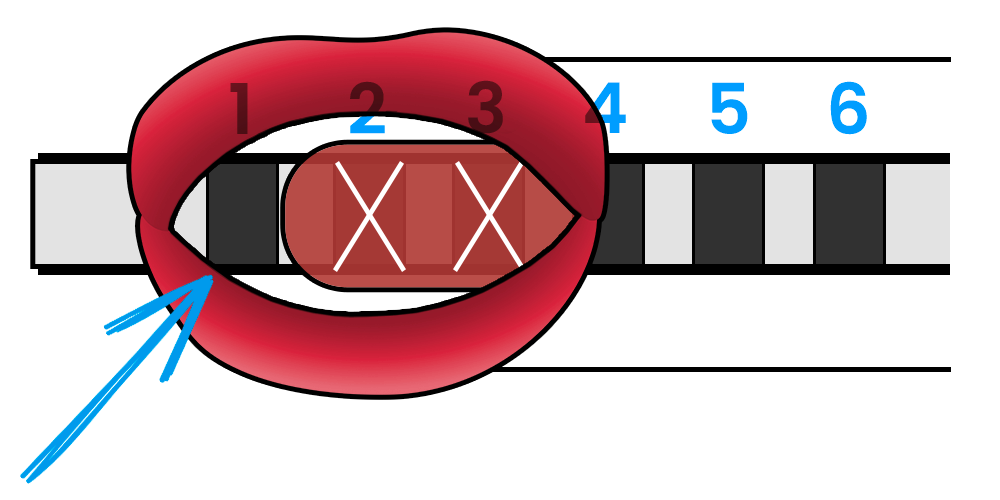
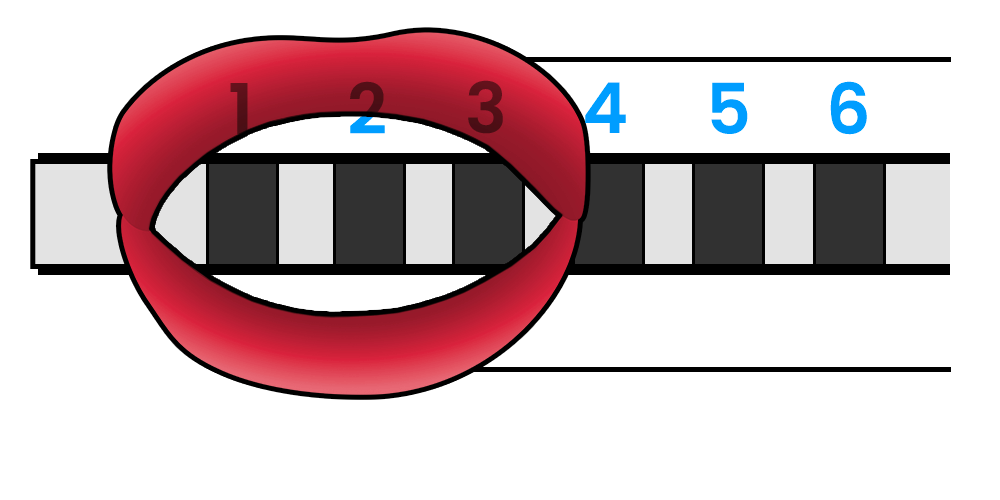

Comments
Got something to say? Post a comment below.